2011 Peugeot 308 CC engine
[x] Cancel search: enginePage 107 of 292

7
!
105
SAFETY
The ESP/ASR systems offer ex-
ceptional safety in normal driving,
but this should not encourage the
driver to take extra risks or drive at
high speed.
The correct functioning of these
systems depends on observation
of the manufacturer's recommen-
dations on:
- wheels (tyres and rims),
- braking components,
- electronic components,
- repair and assembly procedures.
After an impact, have these sys-
tems checked by a PEUGEOT
dealer or a qualifi ed workshop.
Deactivation
In exceptional conditions (starting a ve-
hicle which is bogged down, stuck in
snow, on soft ground, ...), it may be ad-
visable to deactivate the ASR and ESP
systems, so that the wheels can move
freely and regain grip.
�)
Press the "ESP OFF"
button, located
in the middle of the dashboard.
If this warning lamp comes on in
the instrument panel and the indi-
cator lamp in the button come on,
this indicates that the ASR and
ESP systems are deactivated.
On vehicles fi tted with the 1.6 litre THP 200 hp
engine, this action also deactivates the auto-
matic operation of hazard warning lamps.
Reactivation
These systems are reactivated automati-
cally each time the ignition is switched
back on or from 30 mph (50 km/h) (except
in the case of the 1.6 litre THP 200 hp
petrol engine).
�)
Press the "ESP OFF"
button again
to reactivate them manually.
Operating fault
If this warning lamp comes on,
accompanied by an audible
signal and a message in the
screen, this indicates a mal-
function of these systems.
Have it checked by a PEUGEOT dealer
or a qualifi ed workshop.
TRAJECTORY CONTROL
SYSTEMS
Activation
These systems are activated automati-
cally each time the vehicle is started.
Anti-slip regulation (ASR) and
electronic stability programme
(ESP)
They come into operation in the event
of a grip or trajectory problem.
This is indicated by fl ashing of
this warning lamp in the instru-
ment panel.
The anti-slip regulation (also known as
Traction Control) optimises traction to
prevent skidding of the wheels, by acting
on the brakes of the driving wheels and
on the engine.
The electronic stability programme acts
on the brake of one or more wheels and
on the engine to keep the vehicle on the
trajectory required by the driver, within
the limits of the laws of physics. On vehicles fi tted with the 1.6 litre THP
200 hp engine, this action also reacti-
vates the automatic operation of hazard
warning lamps.
Page 110 of 292
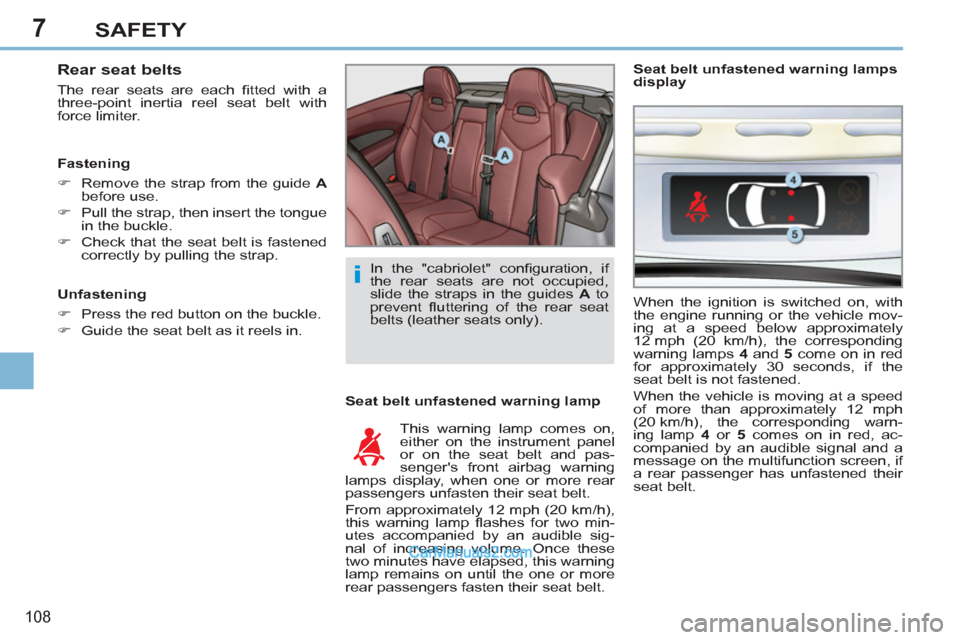
7
i
108
SAFETY
Rear seat belts
The rear seats are each fi tted with a
three-point inertia reel seat belt with
force limiter.
Seat belt unfastened warning lamp
This warning lamp comes on,
either on the instrument panel
or on the seat belt and pas-
senger's front airbag warning
lamps display, when one or more rear
passengers unfasten their seat belt.
From approximately 12 mph (20 km/h),
this warning lamp fl ashes for two min-
utes accompanied by an audible sig-
nal of increasing volume. Once these
two minutes have elapsed, this warning
lamp remains on until the one or more
rear passengers fasten their seat belt.
Fastening
�)
Remove the strap from the guide A
before use.
�)
Pull the strap, then insert the tongue
in the buckle.
�)
Check that the seat belt is fastened
correctly by pulling the strap.
Seat belt unfastened warning lamps
display
When the ignition is switched on, with
the engine running or the vehicle mov-
ing at a speed below approximately
12 mph (20 km/h), the corresponding
warning lamps 4
and 5
come on in red
for approximately 30 seconds, if the
seat belt is not fastened.
When the vehicle is moving at a speed
of more than approximately 12 mph
(20 km/h), the corresponding warn-
ing lamp 4
or 5
comes on in red, ac-
companied by an audible signal and a
message on the multifunction screen, if
a rear passenger has unfastened their
seat belt.
Unfastening
�)
Press the red button on the buckle.
�)
Guide the seat belt as it reels in. In the "cabriolet" confi guration, if
the rear seats are not occupied,
slide the straps in the guides A
to
prevent fl uttering of the rear seat
belts (leather seats only).
Page 124 of 292

8
!
i
!
122
DRIVING
When parking on a slope, direct
your wheels against the pavement,
apply the parking brake and en-
gage a gear.
PARKING BRAKE
Applying
�)
Pull the parking brake lever fully up
to immobilise your vehicle.
When the vehicle is being driven,
if this warning lamp and the STOP
warning lamp come on, accom-
panied by an audible signal and a
message on the multifunction screen, this
indicates that the parking brake is still on or
has not been properly released.
Releasing
�)
Pull the parking brake lever gently,
press the release button then lower
the lever fully.
6-SPEED MANUAL GEARBOX
As a safety precaution and to facili-
tate starting of the engine:
- always select neutral,
- press the clutch pedal.
Only engage reverse gear when
the vehicle is stationary with the
engine at idle.
Engaging reverse gear
�)
Raise the ring under the knob and
move the gear lever to the left then
forwards.
Engaging 5 th or 6 th gear
�)
Move the lever fully to the right to
engage 5 th or 6 th gear.
Page 125 of 292
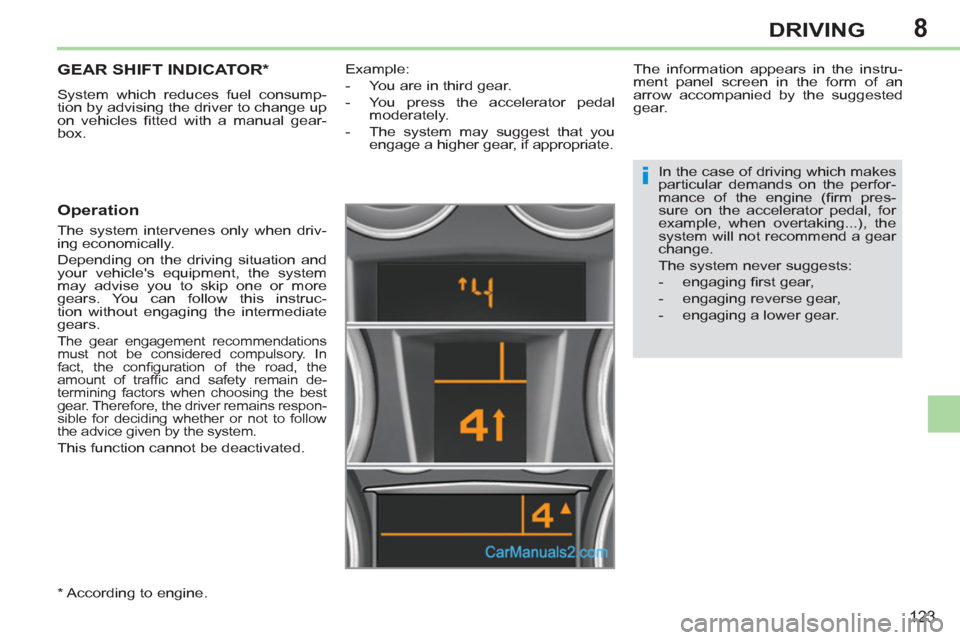
8
i
123
DRIVING
GEAR SHIFT INDICATOR *
System which reduces fuel consump-
tion by advising the driver to change up
on vehicles fi tted with a manual gear-
box.
Operation
The system intervenes only when driv-
ing economically.
Depending on the driving situation and
your vehicle's equipment, the system
may advise you to skip one or more
gears. You can follow this instruc-
tion without engaging the intermediate
gears.
The gear engagement recommendations
must not be considered compulsory. In
fact, the confi guration of the road, the
amount of traffi c and safety remain de-
termining factors when choosing the best
gear. Therefore, the driver remains respon-
sible for deciding whether or not to follow
the advice given by the system.
This function cannot be deactivated.
The information appears in the instru-
ment panel screen in the form of an
arrow accompanied by the suggested
gear.
In the case of driving which makes
particular demands on the perfor-
mance of the engine (fi rm pres-
sure on the accelerator pedal, for
example, when overtaking...), the
system will not recommend a gear
change.
The system never suggests:
- engaging fi rst gear,
- engaging reverse gear,
- engaging a lower gear.
*
According to engine.
Example:
- You are in third gear.
- You press the accelerator pedal
moderately.
- The system may suggest that you
engage a higher gear, if appropriate.
Page 126 of 292
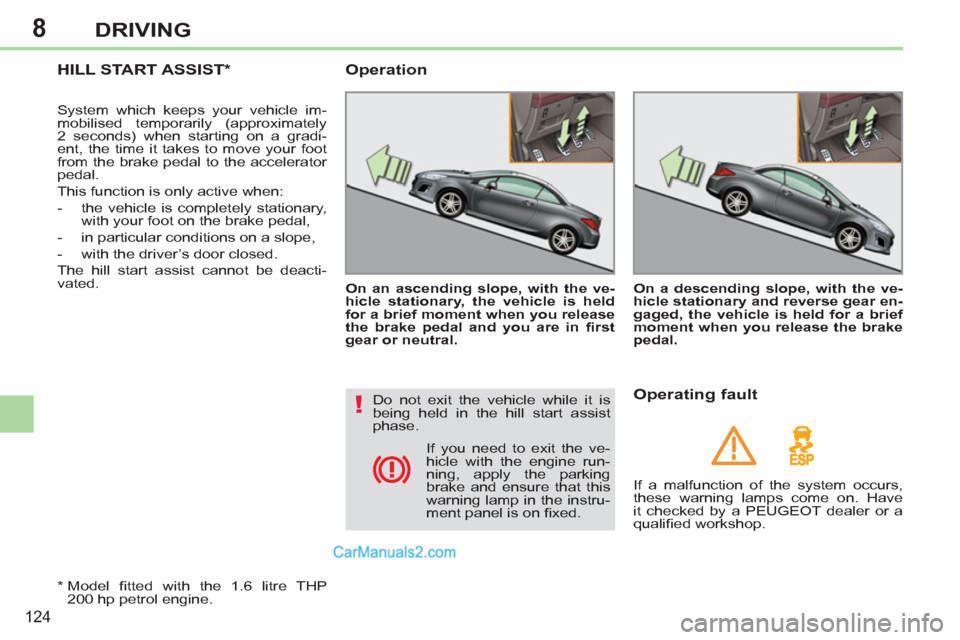
8
!
124
DRIVING
HILL START ASSIST *
System which keeps your vehicle im-
mobilised temporarily (approximately
2 seconds) when starting on a gradi-
ent, the time it takes to move your foot
from the brake pedal to the accelerator
pedal.
This function is only active when:
- the vehicle is completely stationary,
with your foot on the brake pedal,
- in particular conditions on a slope,
- with the driver’s door closed.
The hill start assist cannot be deacti-
vated.
On an ascending slope, with the ve-
hicle stationary, the vehicle is held
for a brief moment when you release
the brake pedal and you are in fi rst
gear or neutral.
Operation
On a descending slope, with the ve-
hicle stationary and reverse gear en-
gaged, the vehicle is held for a brief
moment when you release the brake
pedal.
*
Model fi tted with the 1.6 litre THP
200 hp petrol engine.
Do not exit the vehicle while it is
being held in the hill start assist
phase.
Operating fault
If a malfunction of the system occurs,
these warning lamps come on. Have
it checked by a PEUGEOT dealer or a
qualifi ed workshop. If you need to exit the ve-
hicle with the engine run-
ning, apply the parking
brake and ensure that this
warning lamp in the instru-
ment panel is on fi xed.
Page 127 of 292
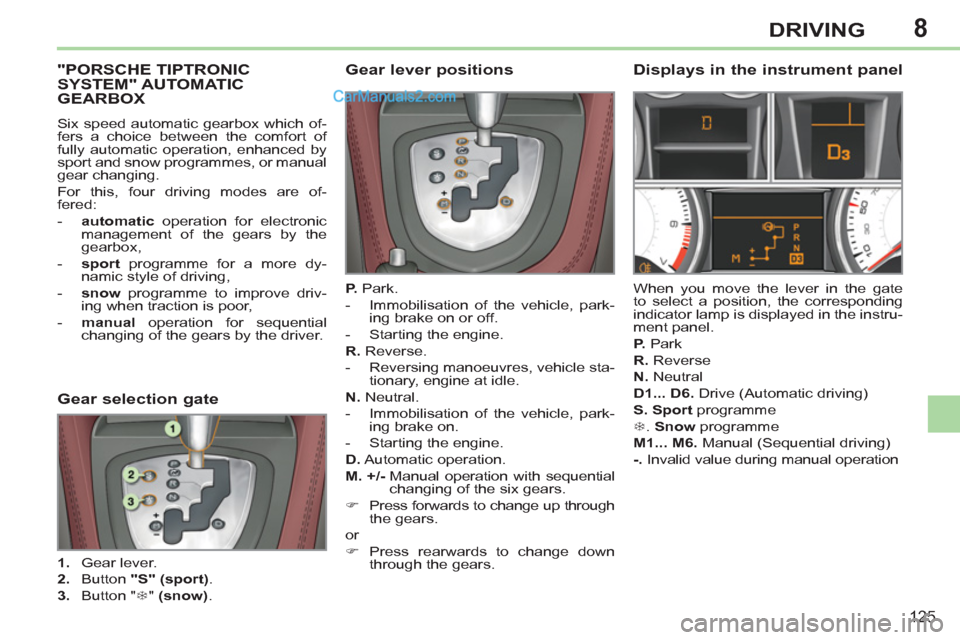
8
125
DRIVING
"PORSCHE TIPTRONIC
SYSTEM" AUTOMATIC
GEARBOX
Six speed automatic gearbox which of-
fers a choice between the comfort of
fully automatic operation, enhanced by
sport and snow programmes, or manual
gear changing.
For this, four driving modes are of-
fered:
- automatic
operation for electronic
management of the gears by the
gearbox,
- sport
programme for a more dy-
namic style of driving,
- snow
programme to improve driv-
ing when traction is poor,
- manual
operation for sequential
changing of the gears by the driver.
Gear lever positions
P.
Park.
- Immobilisation of the vehicle, park-
ing brake on or off.
- Starting the engine.
R.
Reverse.
- Reversing manoeuvres, vehicle sta-
tionary, engine at idle.
N.
Neutral.
- Immobilisation of the vehicle, park-
ing brake on.
- Starting the engine.
D.
Automatic operation.
M. +/-
Manual operation with sequential
changing of the six gears.
�)
Press forwards to change up through
the gears.
or
�)
Press rearwards to change down
through the gears.
Displays in the instrument panel
When you move the lever in the gate
to select a position, the corresponding
indicator lamp is displayed in the instru-
ment panel.
P.
Park
R.
Reverse
N.
Neutral
D1... D6.
Drive (Automatic driving)
S.
Sport
programme
�7
. Snow
programme
M1... M6.
Manual (Sequential driving)
-.
Invalid value during manual operation
Gear selection gate
1.
Gear lever.
2.
Button "S"
(sport)
.
3.
Button " �7
" (snow)
.
Page 128 of 292
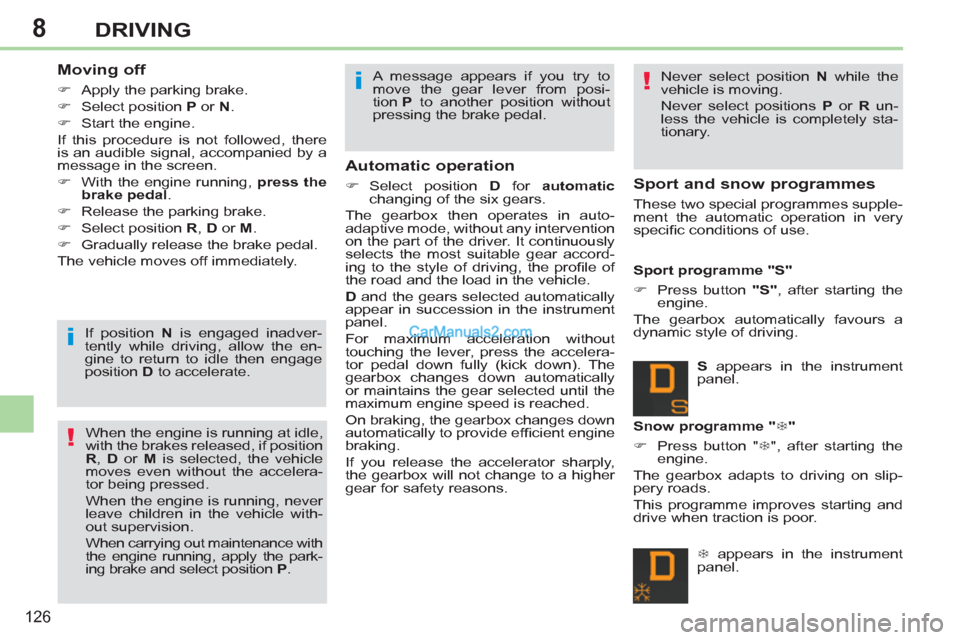
8
!
!
i
i
126
DRIVING
Moving off
�)
Apply the parking brake.
�)
Select position P
or N
.
�)
Start the engine.
If this procedure is not followed, there
is an audible signal, accompanied by a
message in the screen.
�)
With the engine running, press the
brake pedal.
�)
Release the parking brake.
�)
Select position R
, D
or M
.
�)
Gradually release the brake pedal.
The vehicle moves off immediately.
If position N
is engaged inadver-
tently while driving, allow the en-
gine to return to idle then engage
position D
to accelerate.
When the engine is running at idle,
with the brakes released, if position
R
, D
or M
is selected, the vehicle
moves even without the accelera-
tor being pressed.
When the engine is running, never
leave children in the vehicle with-
out supervision.
When carrying out maintenance with
the engine running, apply the park-
ing brake and select position P
. A message appears if you try to
move the gear lever from posi-
tion P
to another position without
pressing the brake pedal.
Automatic operation
�)
Select position D
for automatic
changing of the six gears.
The gearbox then operates in auto-
adaptive mode, without any intervention
on the part of the driver. It continuously
selects the most suitable gear accord-
ing to the style of driving, the profi le of
the road and the load in the vehicle.
D
and the gears selected automatically
appear in succession in the instrument
panel.
For maximum acceleration without
touching the lever, press the accelera-
tor pedal down fully (kick down). The
gearbox changes down automatically
or maintains the gear selected until the
maximum engine speed is reached.
On braking, the gearbox changes down
automatically to provide effi cient engine
braking.
If you release the accelerator sharply,
the gearbox will not change to a higher
gear for safety reasons. Never select position N
while the
vehicle is moving.
Never select positions P
or R
un-
less the vehicle is completely sta-
tionary.
Sport and snow programmes
These two special programmes supple-
ment the automatic operation in very
specifi c conditions of use.
Sport programme "S"
�)
Press button "S"
, after starting the
engine.
The gearbox automatically favours a
dynamic style of driving.
S
appears in the instrument
panel.
Snow programme " �7
"
�)
Press button " �7
", after starting the
engine.
The gearbox adapts to driving on slip-
pery roads.
This programme improves starting and
drive when traction is poor.
�7
appears in the instrument
panel.
Page 129 of 292
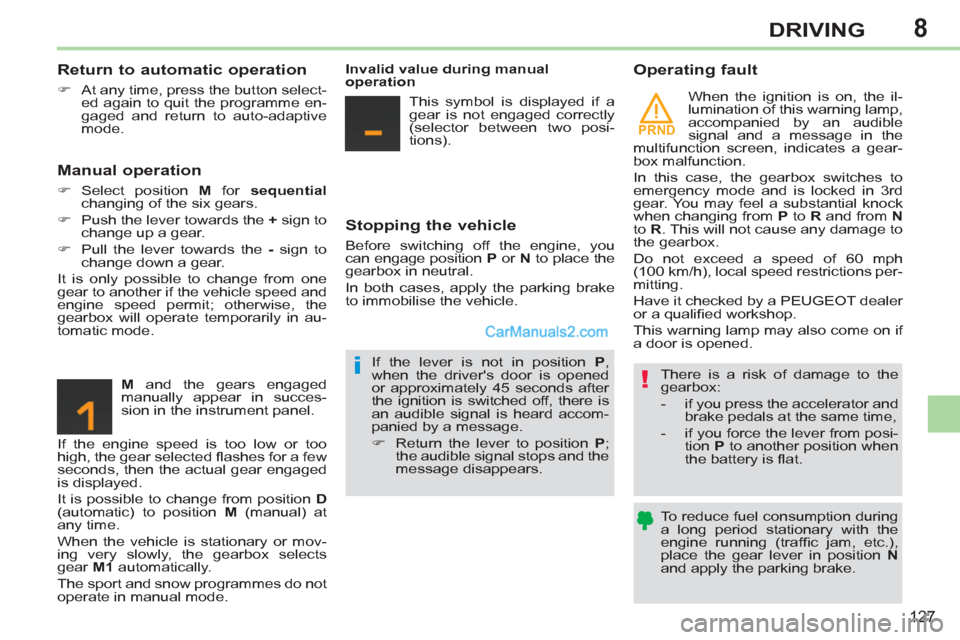
8
PRND
!i
127
DRIVING
Return to automatic operation
�)
At any time, press the button select-
ed again to quit the programme en-
gaged and return to auto-adaptive
mode.
Manual operation
�)
Select position M
for sequential
changing of the six gears.
�)
Push the lever towards the +
sign to
change up a gear.
�)
Pull the lever towards the -
sign to
change down a gear.
It is only possible to change from one
gear to another if the vehicle speed and
engine speed permit; otherwise, the
gearbox will operate temporarily in au-
tomatic mode.
M
and the gears engaged
manually appear in succes-
sion in the instrument panel.
If the engine speed is too low or too
high, the gear selected fl ashes for a few
seconds, then the actual gear engaged
is displayed.
It is possible to change from position D
(automatic) to position M
(manual) at
any time.
When the vehicle is stationary or mov-
ing very slowly, the gearbox selects
gear M1
automatically.
The sport and snow programmes do not
operate in manual mode.
Invalid value during manual
operation
This symbol is displayed if a
gear is not engaged correctly
(selector between two posi-
tions).
Stopping the vehicle
Before switching off the engine, you
can engage position P
or N
to place the
gearbox in neutral.
In both cases, apply the parking brake
to immobilise the vehicle.
Operating fault
There is a risk of damage to the
gearbox:
- if you press the accelerator and
brake pedals at the same time,
- if you force the lever from posi-
tion P
to another position when
the battery is fl at.
To reduce fuel consumption during
a long period stationary with the
engine running (traffi c jam, etc.),
place the gear lever in position N
and apply the parking brake.
If the lever is not in position P
,
when the driver's door is opened
or approximately 45 seconds after
the ignition is switched off, there is
an audible signal is heard accom-
panied by a message.
�)
Return the lever to position P
;
the audible signal stops and the
message disappears.
When the ignition is on, the il-
lumination of this warning lamp,
accompanied by an audible
signal and a message in the
multifunction screen, indicates a gear-
box malfunction.
In this case, the gearbox switches to
emergency mode and is locked in 3rd
gear. You may feel a substantial knock
when changing from P
to R
and from N
to R
. This will not cause any damage to
the gearbox.
Do not exceed a speed of 60 mph
(100 km/h), local speed restrictions per-
mitting.
Have it checked by a PEUGEOT dealer
or a qualifi ed workshop.
This warning lamp may also come on if
a door is opened.